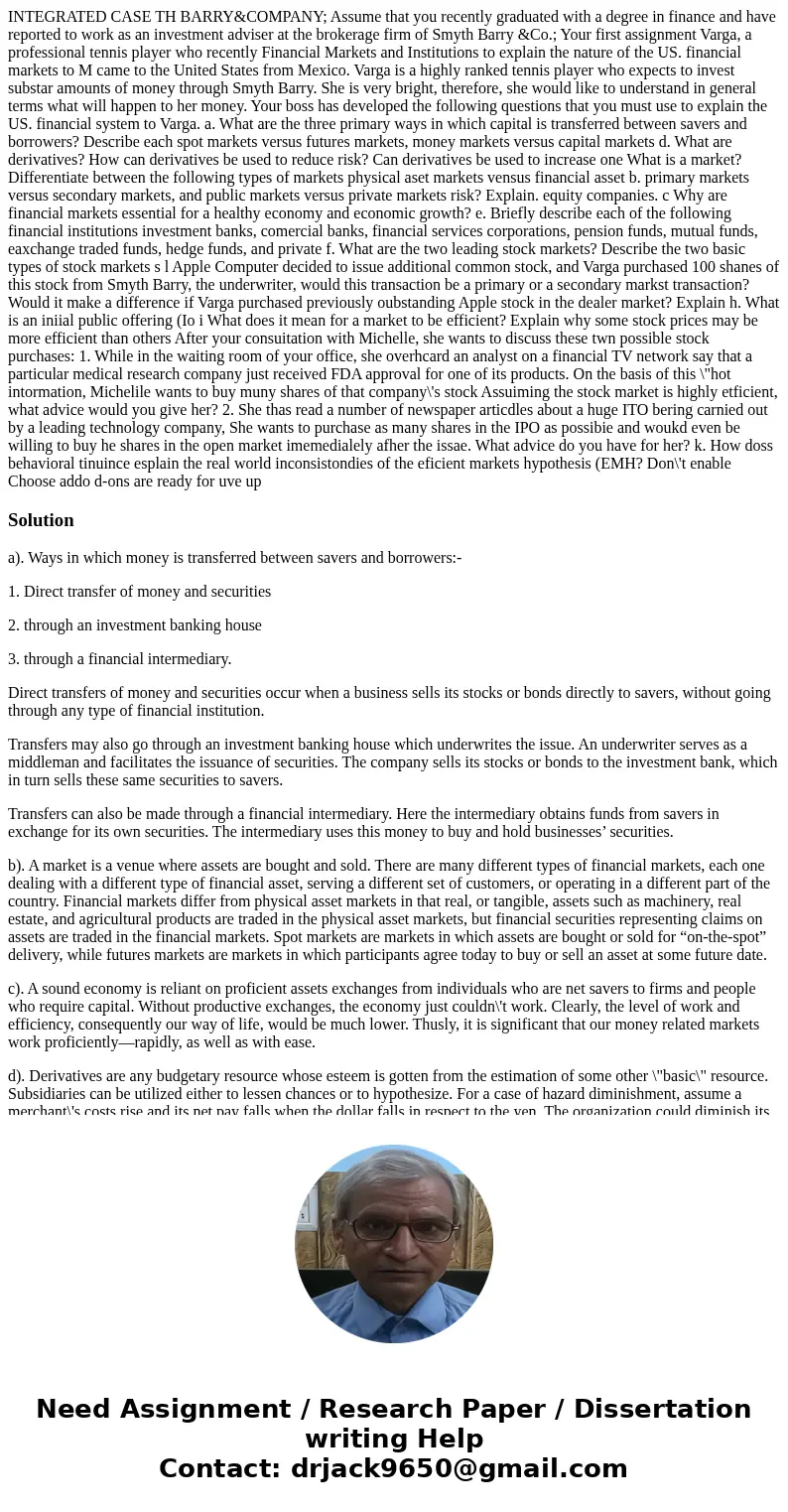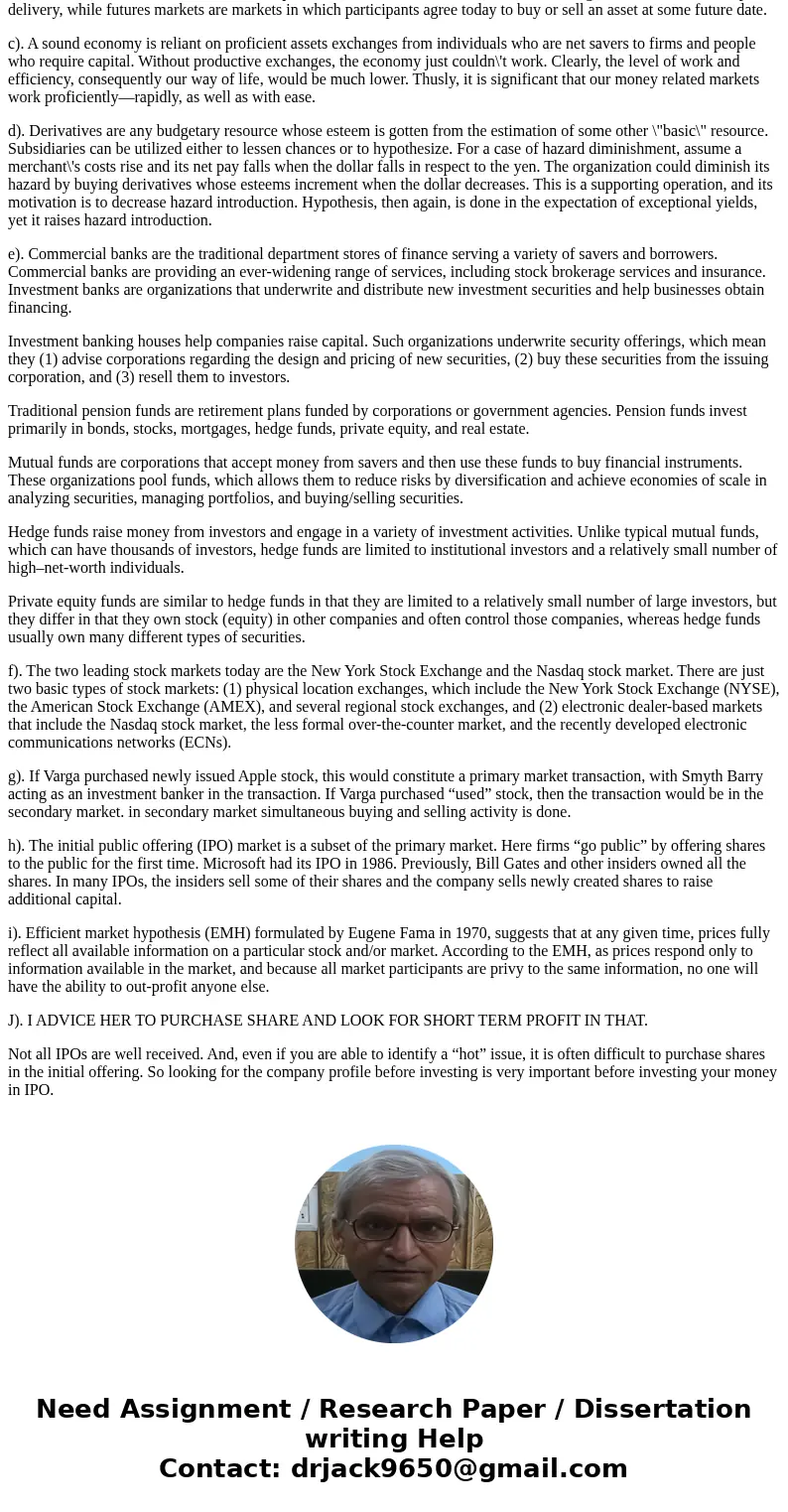INTEGRATED CASE TH BARRYCOMPANY Assume that you recently gra
Solution
a). Ways in which money is transferred between savers and borrowers:-
1. Direct transfer of money and securities
2. through an investment banking house
3. through a financial intermediary.
Direct transfers of money and securities occur when a business sells its stocks or bonds directly to savers, without going through any type of financial institution.
Transfers may also go through an investment banking house which underwrites the issue. An underwriter serves as a middleman and facilitates the issuance of securities. The company sells its stocks or bonds to the investment bank, which in turn sells these same securities to savers.
Transfers can also be made through a financial intermediary. Here the intermediary obtains funds from savers in exchange for its own securities. The intermediary uses this money to buy and hold businesses’ securities.
b). A market is a venue where assets are bought and sold. There are many different types of financial markets, each one dealing with a different type of financial asset, serving a different set of customers, or operating in a different part of the country. Financial markets differ from physical asset markets in that real, or tangible, assets such as machinery, real estate, and agricultural products are traded in the physical asset markets, but financial securities representing claims on assets are traded in the financial markets. Spot markets are markets in which assets are bought or sold for “on-the-spot” delivery, while futures markets are markets in which participants agree today to buy or sell an asset at some future date.
c). A sound economy is reliant on proficient assets exchanges from individuals who are net savers to firms and people who require capital. Without productive exchanges, the economy just couldn\'t work. Clearly, the level of work and efficiency, consequently our way of life, would be much lower. Thusly, it is significant that our money related markets work proficiently—rapidly, as well as with ease.
d). Derivatives are any budgetary resource whose esteem is gotten from the estimation of some other \"basic\" resource. Subsidiaries can be utilized either to lessen chances or to hypothesize. For a case of hazard diminishment, assume a merchant\'s costs rise and its net pay falls when the dollar falls in respect to the yen. The organization could diminish its hazard by buying derivatives whose esteems increment when the dollar decreases. This is a supporting operation, and its motivation is to decrease hazard introduction. Hypothesis, then again, is done in the expectation of exceptional yields, yet it raises hazard introduction.
e). Commercial banks are the traditional department stores of finance serving a variety of savers and borrowers. Commercial banks are providing an ever-widening range of services, including stock brokerage services and insurance. Investment banks are organizations that underwrite and distribute new investment securities and help businesses obtain financing.
Investment banking houses help companies raise capital. Such organizations underwrite security offerings, which mean they (1) advise corporations regarding the design and pricing of new securities, (2) buy these securities from the issuing corporation, and (3) resell them to investors.
Traditional pension funds are retirement plans funded by corporations or government agencies. Pension funds invest primarily in bonds, stocks, mortgages, hedge funds, private equity, and real estate.
Mutual funds are corporations that accept money from savers and then use these funds to buy financial instruments. These organizations pool funds, which allows them to reduce risks by diversification and achieve economies of scale in analyzing securities, managing portfolios, and buying/selling securities.
Hedge funds raise money from investors and engage in a variety of investment activities. Unlike typical mutual funds, which can have thousands of investors, hedge funds are limited to institutional investors and a relatively small number of high–net-worth individuals.
Private equity funds are similar to hedge funds in that they are limited to a relatively small number of large investors, but they differ in that they own stock (equity) in other companies and often control those companies, whereas hedge funds usually own many different types of securities.
f). The two leading stock markets today are the New York Stock Exchange and the Nasdaq stock market. There are just two basic types of stock markets: (1) physical location exchanges, which include the New York Stock Exchange (NYSE), the American Stock Exchange (AMEX), and several regional stock exchanges, and (2) electronic dealer-based markets that include the Nasdaq stock market, the less formal over-the-counter market, and the recently developed electronic communications networks (ECNs).
g). If Varga purchased newly issued Apple stock, this would constitute a primary market transaction, with Smyth Barry acting as an investment banker in the transaction. If Varga purchased “used” stock, then the transaction would be in the secondary market. in secondary market simultaneous buying and selling activity is done.
h). The initial public offering (IPO) market is a subset of the primary market. Here firms “go public” by offering shares to the public for the first time. Microsoft had its IPO in 1986. Previously, Bill Gates and other insiders owned all the shares. In many IPOs, the insiders sell some of their shares and the company sells newly created shares to raise additional capital.
i). Efficient market hypothesis (EMH) formulated by Eugene Fama in 1970, suggests that at any given time, prices fully reflect all available information on a particular stock and/or market. According to the EMH, as prices respond only to information available in the market, and because all market participants are privy to the same information, no one will have the ability to out-profit anyone else.
J). I ADVICE HER TO PURCHASE SHARE AND LOOK FOR SHORT TERM PROFIT IN THAT.
Not all IPOs are well received. And, even if you are able to identify a “hot” issue, it is often difficult to purchase shares in the initial offering. So looking for the company profile before investing is very important before investing your money in IPO.


 Homework Sourse
Homework Sourse